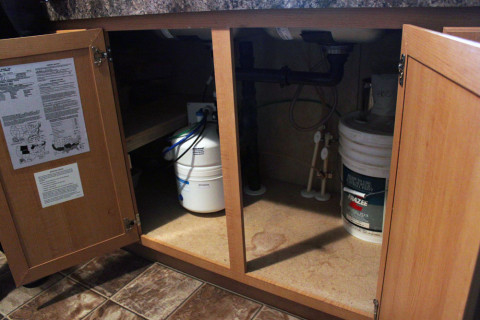
This point-of-use filtration system is connected to a mobile home resident’s sink. Assemblyman Garcia’s proposed legislation would support the installation of point-of-use filtration systems in rural communities across California. Photo: AMBER AMAYA / Coachella Unincorporated
IVAN VALENZUELA and CHRISTIAN MENDEZ / Coachella Unincorporated
COACHELLA — A proposed bill for combating arsenic-tainted water in rural California communities, including those in the eastern Coachella Valley, is one step closer to becoming a reality.
Assemblyman Eduardo Garcia’s AB 434 is in the Senate Committee on Environmental Quality after receiving overwhelming (77-0) bipartisan support from the Assembly.
Garcia, who represents the 56th assembly district, sought to amend the California Safe Drinking Water Act in February as a way to require regulations from the State Water Resources Control Board to address unsafe levels of arsenic in groundwater.
California regulations put the maximum contaminant level (MCL) for arsenic at 10 parts per billion (PPB). But testing in the Coachella Valley has shown that 24 local water systems were found to have arsenic levels above the legal limit, ranging from 13 to 44 parts per billion.
Many of the rural communities affected by the arsenic contamination are home to farm workers and mobile home park residents who must rely on water from private wells rather than municipal sources.
Assemblyman Garcia said his bill would help other rural California communities implement systems like the point-of-use filters to improve water quality.
“Everyone should have access to clean and reliable drinking water, no matter where you live,” said Assemblyman Garcia in a press release. “Access to clean drinking water is a right, not a privilege. My point-of-use legislation will help ensure that people most impacted by unsafe levels of arsenic in their drinking water have access to cost effective solutions that help remediate the problem.”
If passed, AB 434 would support the expansion of the point-of-use filtration systems in rural communities throughout California.
The bill needs a two-thirds vote to make it through the Senate, and if passed will go into effect immediately because of its urgent nature.
According to the Environmental Protection Agency (EPA), arsenic can enter drinking water sources from agricultural runoff or from industrial operations, as well as the erosion of naturally occurring underground deposits. Prolonged exposure is linked with a host of health issues, including several types of cancers, reproductive problems, serious skin problems, thyroid issues and damage to the central nervous system.
To combat the high levels of arsenic in the water, Pueblo Unido Community Development Corporation has been piloting point-of-use filtration systems in the eastern Coachella Valley to treat drinking water in homes, schools, and businesses. The filtration systems are installed under a sink or faucet to treat the drinking water that goes through the pipes, and are meant to be a temporary solution for communities that are not connected to local municipal services.
Sergio Carranza, executive director of Pueblo Unido CDC, said the bill would help secure safe drinking water for all families in the east valley.
“The idea of this bill is to create an ongoing resource for the community, specifically those who are geographically located in a place of less visibility to consolidate to municipal service,” said Carranza. “The bill also has, as an objective, not to leave anybody behind. It’s a resource; it’s an opportunity for families.”
Access to safe, affordable drinking water has major health implications, according to the , which has worked with the California Endowment and Pueblo Unido on the Agua4All campaign in the Eastern Coachella Valley and in other pilot communities.
“In lieu of drinking contaminated water, many low-income families spend more than 10 percent of their earnings buying bottled water or other water alternatives,” according to the RCAC website. “Many also choose to purchase sugar sweetened beverages instead. Water is the healthy choice, particularly since diabetes in California has increased by 35 percent in the last 10 years.”